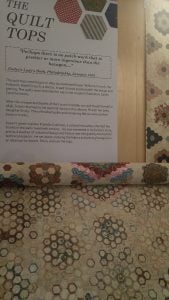By Lauren Poirier
Emerging onto the first floor of Quinn Hall out of the wind and rain on Monday, April 22, I entered into a lobby full of graduate and undergraduate students, faculty, and community members chatting over refreshments. The majority of guests, however, were volleying for entrance into the TMD Department’s gallery space, where the famed quilts of “An American Quilt: Unfolding a Story of Family and Slavery” were displayed.
The exhibit was inspired by Rachel May, author of the book by the same name and PhD alum who graduated from URI in 2015. While she was earning her PhD in English at URI, May happened to take a Textiles, Fashion Merchandising and Design class and became fascinated by a pair of quilts made in the 19th century and donated to URI by Franklin Cushman, great-nephew of Susan and Hasell Williams. The Williamses were a slave-owning couple who met in Providence while Hassel was attending medical school at Brown University. Shortly after they were married, they moved to Charleston, South Carolina, where they owned four slaves by the names of Minerva, Eliza, Jane, and Juba.
Inside the gallery, guests stood in a line wrapping around the displays ooh-ing and ah-ing over 19th-century men’s and women’s apparel that belonged to the Williams family. The cases displayed a men’s suit jacket and pants, a wedding dress, a pregnancy smock, and the famed quilts that Rachel May was so enamored by that she wrote an entire book about them. I was struck by the immaculate condition these century-old pieces were in and the intricate detailing that must have taken hours upon hours to sew. The clothing painted a picture of an era in which clothing was carefully hand-stitched, rather than factory-made, and life in general was lived at a slower pace. It was easy to understand how May could become enthralled by a collection such as this one, and the darker history that lay behind it.
Once all the guests had an opportunity to admire the exhibit, the lecture portion of the evening began. Rebecca Kelly, the coordinator of the event and adjunct faculty member of the TMD Department, enlightened the audience about the logistical difficulties in installing garments of such old age. In order to hang the quilts in their display case without damaging them, Kelly and the graduate students made use of special magnets that would be non-invasive to the delicate fabric. “You probably didn’t notice them in your first pass through, but now that I told you they’re there, feel free to go back and investigate,” she laughed.
After Kelly’s introduction, the audience heard from Linda Welters, a professor in the TMD Department. According to Linda Welters, “We received this collection in 1952, but it took a PhD candidate to open our eyes to the importance of it.” May would soon come to learn the finer details of the two quilts’ history. “It was a shock to her to learn that these quilts she so admired were actually created by slaveholders. I think after that they became even more fascinating,” noted Welters.
Rachel May’s book delves into her exploration of this 19th-century family, exploring their history through the medium of the quilt. As Professor Welters explained to us, May’s background is in creative writing, so she was able to present this historical tale in a fresh and enlightening way, offering both facts about the family, and her own speculation about the harder-to-trace enslaved women who worked for them. She weaves in the story of the Williamses with the threads of the quilt that introduced her to the family in the first place.
Despite May’s dutiful digging, the history of the Williams family and the people they enslaved is still murky in places. Of course, May must have known that she was undertaking a difficult task when she set out to better understand the lives of four enslaved people who lived over a century ago. However, as I walked around the exhibit it struck me how important it is that we simply try to understand what the lives of these people were like. While history cannot be changed, it can certainly be studied and learned from, a task made all the more interesting thanks to writers like Rachel May.
Lauren Poirier is a sophomore English and public relations major and intern at the University’s Department of Marketing and Communications.
